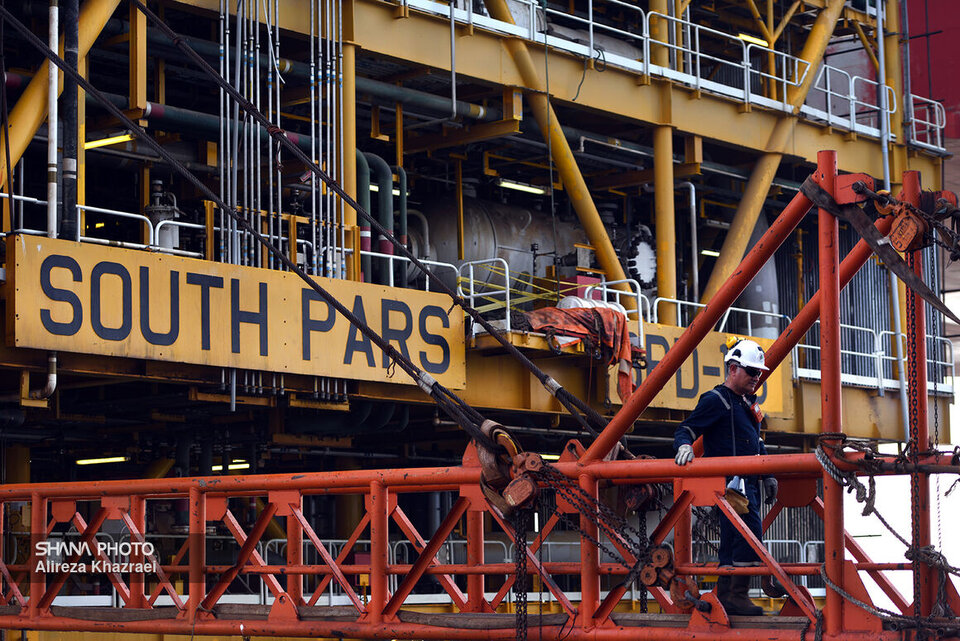In an exclusive interview with SHANA, POGC CEO Mohammad Hossein Motejalli added a 30 mcm/d increase in winter output of the world’s largest joint gas field has been planned through putting several wells of Phase 11 and platform 13A as well as a new pipeline of Phase 16 into operation.
Shared by Iran and Qatar in the Persian Gulf, the South Pars gas field holds 50 percent of Iran’s gas reserves and accounts for 70 percent of the country’s gas supply.
Although the development of the gas field started over 23 years ago, different projects for maintaining and increasing its production are underway.
Given Iran and Qatar’s gas extraction in the past years, pressure in the South Pars field’s reservoir has started to decrease gradually. Hence, pressure-boosting projects are necessary for keeping gas production at its highest level and meeting domestic need.
As Iran’s Oil Minister Javad Owji has said, the country will face a gas imbalance of over 250 mcm/d in winter and it is important to preserve the current production capacity.
In addition to the implementation of energy efficiency projects in different sectors, the increase of gas output is a must.
To that end, Motejalli stated, the development of other gas fields, namely Kish, North Pars, Balal, and Farzad B, is in progress.
According to him, an Iranian contractor and its foreign partners are conducting onshore and offshore studies on boosting pressure in the South Pars gas field.
Below is the full transcript of POGC chief’s interview with SHANA:
What measures are being taken to boost gas output in the South Pars field in winter other than the early extraction from Phase 11?
Pars Oil and Gas Company is in charge of maintaining and increasing gas production in the South Pars field. In this regard, Phase 11 gas production started during a ceremony attended by the president and held concurrent with the Government Week. The initial gas output of Phase 11 stood at 7.5 mcm/d and extraction from platform 11B is expected to hit 15 mcm/d in winter.
Furthermore, it has been planned to boost gas extraction from platform 13A. Gas production from wells of platform 13A, which had been earlier damaged, is complicated. We, however, are trying to use four wells and increase the platform’s gas production to an estimated volume of 10 mcm/d in winter.
The new offshore pipeline of Phase 16 is scheduled to become operational next month and will increase this phase’s output by 8 mcm/d. Now, its connection to an onshore refinery is on the agenda.
To what extent will the aforementioned measures increase Iran’s gas production capacity in the South Pars field next winter?
Based on the plan, totally 30 mcm/d will be added to the South Pars field’s gas production and the winter output will surpass 730 mcm/d by exploiting several wells of Phase 11 and platform 13A and launching the new pipeline of Phase 16.
Iran and Qatar have been extracting gas from the joint South Pars field for more than two decades. Consequently, gas pressure drop in the field will be expected in the coming years. What is Pars Oil and Gas Company’s plan for boosting pressure?
We are right now conducting onshore and offshore studies on boosting pressure in two separate directions as we do not want to miss the chance.
Nargan Company and its foreign partners are the consultants for onshore and offshore pressure-boosting studies. Apart from underway conceptual research, intensive talks on basic studies with Iranian and foreign consultants will be also held.
Considering that an Iranian company has been selected for doing pressure-boosting studies, will you use homegrown equipment, including compressors?
We should not have a one-sided view when it comes to the equipment needed for the project as the boosting of a gas field’s pressure is very important to the country. Hence, we will count on both domestic and foreign companies.
We have studied the manufacturing of pressure-boosting platforms inside the country while foreign companies are also under study and the final decision will be made within few months. Regarding compressors, both Iranian and foreign companies will cooperate with us.
Which fields are you developing other than the South Pars field to increase the country’s gas production capacity?
Development of the Kish and Balal fields, basic studies on the North Pars field, and conceptual research on the joint Farzad B field are the main projects for boosting the gas production capacity.
Concerning the Kish field, gas produced in the first phase will be transmitted to Site 1 of Assaluyeh and processed there. Three more phases have been also included in its development project. So, Bandar Aftab Refinery needs to be developed.
Based on a deal we have signed with the Iranian Offshore Engineering and Construction Company (IOEC) as the contractor to develop the Kish field, the early production of the southern field will start in 2024.
Petropars Company is the main contractor of the Balal field. IOEC is building a platform for it and Iran Marine Industrial Company (SADRA) is building its jacket.
What have you done for developing the oil layer of the South Pars field?
Following the affirmation of the contract, we held the first session with the contractor and discussed the development of the second phase of the South Pars field’s oil layer. Now, we are outlining a plan for increasing its oil production. At this stage, we will use the floating production storage and offloading (FPSO) vessel.
As the last question, have you placed an order for building the second platform of Phase 11 of the South Pars field?
We have different plans for building the second platform of Phase 11. The jacket and platform contractors have been picked and the projects are at the engineering stage. SADRA and Iran Shipbuilding and Offshore Industries Complex Company (ISOICO) construct its jacket and platform respectively while Petropars Company builds its pipeline and Petropars Oilfield Services Company (POSCO) is the drilling contractor.


Your Comment